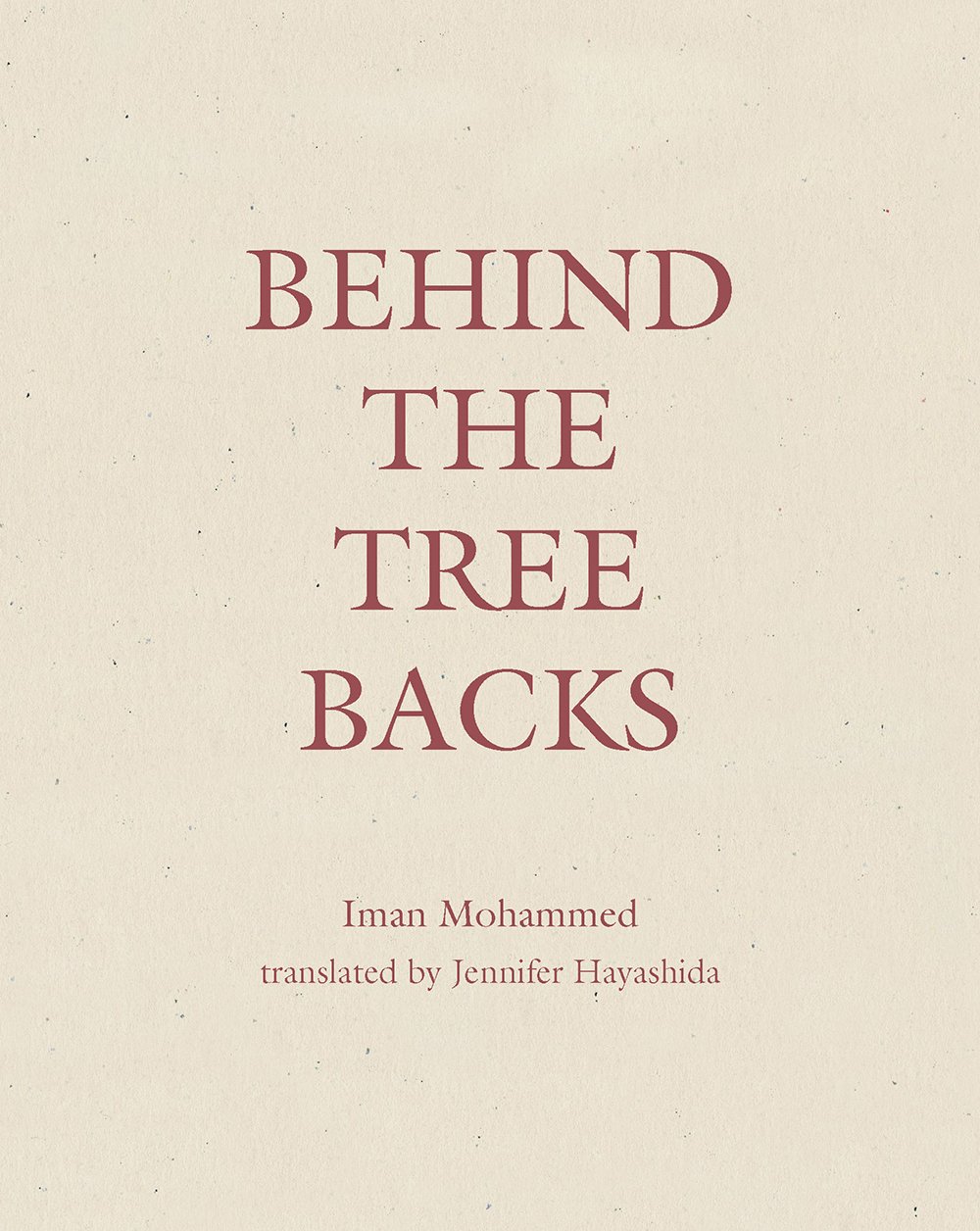Reviewd by Tiffany Troy
Behind the Tree Backs is a striking example of how poets working to destabilize the foundations of capitalism, imperialism, and hegemony do so in the lyric form. In fragmentary form consisting of prose blocks, monostiches, and multi-line stanzas, Iman Mohammed presents violence as it occurs amidst great beauty in the blooms of flowers and the domestic sphere. The poet, however, does not build through any clear line of narrative or a pattern of how violence is deployed and described. Instead, the form works to subvert any of our expectations of how the fabric of violence is patterned.
The collection opens with fragments and white space:
Brain tissue unwillingly ornamenting the greenery:
hortensia, ambra tree, hibiscus, dahlia.Milk teeth of hegemony.
The coupling of body parts ("brain tissue") with summer flowers ("hortensia, ambra tree, hibiscus, dahlia") situates us in time and space, even when the worldscape created by Mohammed is one where the humans and the garden they nurse bend together as objects to be consumed. In the opening poem, the "[m]ilk teeth of hegemony" transform the scene into a political one: by focusing on the "milk teeth" in lieu of any human antagonist, the reification and substitution of the human by its constituent parts is complete. "Milk teeth"—as a kind of feverish delirium and cause of hunger, numbness, and even death–loom throughout the collection.
Each fragment, in turn, serves as its own scene, a vignette placed flush left and near the top in a pool of white space where children and parents alike gather their "survival instincts" in the "feverish delirium" instigated by a system that views its constituents as "pink meat."
In one page, Mohammed writes:
Daydream transforms at night, beneath pillows. Buildings change according to certain gazes, buildings stagger in the rain.
succade
ginger
azure
cyan
The transformation of daydreams at night is literal, as well as metaphorical, as the perceiver-consumer can flatten objects (like buildings) to their fair market valuation or personify them as they "stagger in the rain," objects that may have failed their purpose to house the humans. That, however, is then immediately followed by a kaleidoscope of color, a sort of turn away from the buildings: the tropical colors from the succade (candy to be consumed by children), the golden-yellow hue of ginger, the bright blue of the cloudless sky (or Microsoft's cloud-computing software), and cyan (the in-between the blue and green). Mohammed looks at our nostalgia in things that are not at all benign, but dangerous, in an in-between space in the context of starvation of children in operatives, and where a cloudless sky signals not just a calm afternoon but a threat of danger And where cyan, in turn, becomes sinister, an "army of trees" or "[h]and in hand with the conclusion of the air offensive" at the end of forty days.
Such jagged cuts punctuate this collection because the speaker of Behind the Tree Backs, who "smear[s] my blood across the sculptures' foreheads," consciously searches for "Poisonous plants" that "will break apart the light, light can cut my eyes in a single breath." There is great precision and craft involved, as what is presumed to be the set time and place (the here and now) quickly becomes memories, dreams, and the fantastical. Interspersed throughout the collection is great pathos, as in when the speaker "sketch[es] a snow castle to shelter my mothers," referring perhaps to the fattened up foxes raised for slaughter or hunt.
As noted by Jennifer Hayashida in her Translator's Note, readers of Theresa Hak Kyung Cha, Etel Adnan, and Mei-mei Berssenbrugge will be fans of Mohammed's work. Like Cha's Dictee, Behind the Tree Backs achieves not clarity—if what we mean is a clearly-defined genre, theme, or style—but rather resonance through leaps and fragments. Mohammed gestures to the "Nude Descending the Staircase," and she deploys similar techniques in her depiction of time through not-time, as the speaker's "body beneath the bed," "dream and am dead in the dream, sleep and dream living and dead, I dream and am dead in the dream." These fragments often depict violence against oneself as a (futile) means to achieve a place in the world of the poem, as when the speaker "scrub[s] through the skin into another sphere." This other sphere, however, while teetering and shapeshifting, is one that calls to question the very underpinnings of our socioeconomic and political sphere across generations.

